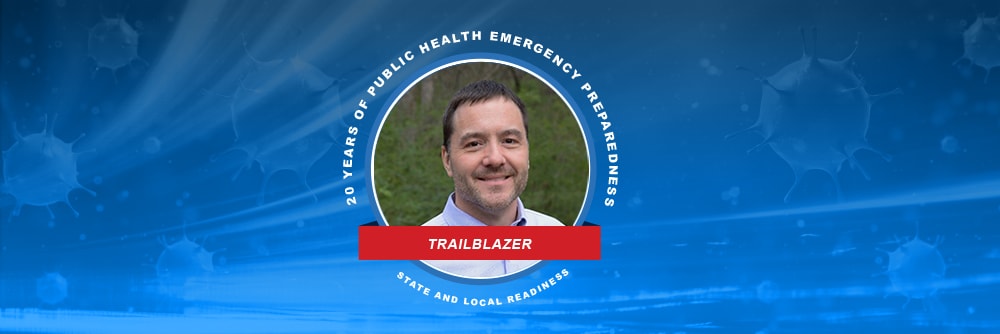Robert Goff

Robert Goff, MPH
Emergency Preparedness Director
Southeast Region of the Tennessee Department of Health
Where were you on 9/11? Were you part of the emergency response?
I was working for the American Red Cross as a community development specialist. I was driving to my office when I heard initial reports on the radio. I recall the disc jockey saying the report seems unreal. When I arrived at my office, which was in a local hospital, I saw images on the TV in a waiting room. I stepped in and watched in disbelief with others in the room. I was watching when the second plane hit. I stared at the TV for a couple of more minutes before it occurred to me that it was really happening. At that point I said out loud, “I better get to work.”
What was your introduction to public health preparedness? How did you get involved with PHEP?
I remained with the American Red Cross until 2003 when I saw that the local health department was hiring a volunteer coordinator for its emergency preparedness program. I figured my Red Cross experience meant I had the experience to apply. I got the job, and, in late 2003, I became the first PHEP volunteer coordinator for a local health department. I remained in the job for 11 months and then moved into my current position.
What do you do on a day-to-day basis related to PHEP activities?
I am the emergency preparedness director for a 10-county region in southeast Tennessee. I am responsible for PHEP activities for the 11 health departments in the region and the regional office.
Over your career, what changes have you seen in PHEP? How has public health preparedness evolved?
For the first few years, the emergency preparedness community was unsure of what role public health could play in response. The threats we were planning for—smallpox and anthrax—didn’t feel like a big threat in southeast Tennessee. Pandemic flu planning in the late 2000s seemed to make some sense, but then H1N1 came and went with little impact. We seemed to finally find a place with response to natural disasters. That isn’t to say that the depth of PHEP programs is response to natural disasters; although, it seems that was how our response community finally understood the benefit of PHEP.
How has PHEP supported preparedness in your jurisdiction? What’s the most significant impact PHEP has made in terms of your jurisdiction’s ability to respond to a public health threat?
We have been fortunate in our region to establish our PHEP program as more than a response to natural disasters. Our region is home to two nuclear power plants. When emergency plans were developed for the plants in the early 1980s, five of our health departments were written into the plans. They had responsibility for monitoring and decontaminating the general population and emergency workers.
My first experience with this type of response was while working with the Red Cross in 2000. Unfortunately, public health personnel were not prepared for their role, which resulted in at least one negative finding. That was in a county that is part of our public health region.
When I came into my current position, I said that our health departments will be better prepared moving forward. We have developed robust radiological response plans. We have also established our program as a strong member of the response community in our region and in Tennessee through radiological response planning.
Reflecting on your career in public health emergency preparedness, what accomplishments are you most proud of?
Our radiological response has gained recognition beyond our region and even our state. My job, however, is to write the plans and develop the resources. The hard work is done by employees in our local health departments and regional office. I’m most proud of what they demonstrate in annual exercises required by and evaluated by the Federal Emergency Management Agency (FEMA). I credit so much of our region’s solid response to COVID-19 to the willingness of our employees to learn response concepts through radiological preparedness.
Other than COVID-19, what public health emergency response experience stands out in your memory and why?
The response to the multistate outbreak of fungal meningitis linked to steroid injections in 2012 stands out. We had developed our first emergency operations center (EOC) in our regional office. This was the first response that truly utilized the EOC. This was before the development of the kinds of modern resources available today. I recall how much we depended on paper and fax machines to communicate internally and across the state. That is one reason it stands out!
How do you maintain momentum and prevent personal burnout in the preparedness field? How do you do the same for your team?
I remind myself and my team often, “This job pays for real life.” While my team does its best to prepare our health departments for the next response, we must remember to take care of ourselves if we want to take care of others. I share as much as I can with my team so that if I am unavailable at the time of the response, they can act. A response should not depend on any one individual. That helps me see on a regular basis how strong my team is.